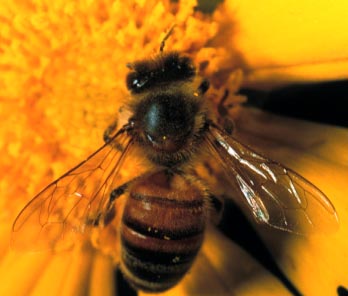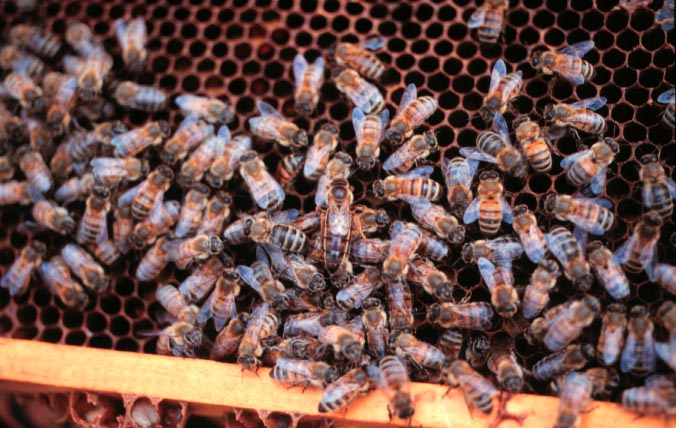
A honey bee, Apis mellifera Linnaeus (Hymenoptera: Apidae), worker.
Photo by Drees.
Common Name: Honey bee
Scientific Name: Apis mellifera Linnaeus
Order: Hymenoptera
Description: Honey bees are somewhat variable in color but are some shade of black, brown or brown intermixed with yellow. They have dense hairs on the pronotum and sparser hair on the abdomen. Microscopically, at least some of the body hairs of bees (Apoidea) are branched (pumose). The abdomen often appears banded. Larvae are legless grubs, white in color.
Honey bees are the only bee in the genus Apis in Texas. Honey bees have several varieties or races and have been bred for honey production, temperament and resistance to disease. These varieties may be recognized to some extent by color and size. However, cross breeding may take place in the wild, so queens from commercial breeders should always be purchased to re-queen colonies. Africanized honey bees or “killer bees” can not easily be differentiated from commercial varieties and require measuring several bees from a colony and comparing measurements. There are several other bees including bumblebees and leaf cutting bees that also collect pollen and nectar. There is a species of stingless wasp that occurs in South Texas that produces honey much like bees.

Honey bee, Apis mellifera Linnaeus (Hymenoptera: Apidae), nest in wall void.
Photo by A. Sparks, Jr.
Life Cycle: Honey bees are social insects. There are three castes of bees: queens, which produce eggs; drones or males, which mate with the queen; and, workers, which are all non reproducing females. The queen lays eggs singly in hexagonal cells of the comb. Larvae hatch from eggs in 3 to 4 days and are fed by worker bees and develop through several stages (instars) in the cells. Cells are capped by worker bees when the larvae pupates. Queen and drones (that develop from unfertilized eggs) are larger than workers and require enlarged cells to develop. Queens complete development in 15 ½ days, drones in 24 days and workers in 21 days for larvae and pupae stages. Only one queen is usually present in a hive. New queens develop in enlarged cells by differential feeding by workers when the existing queen ages or dies or the colony becomes very large. Virgin queens fly on a nuptial flight and are mated by drones from their own colony or other colonies. Queens mate with several drones during the nuptial flight. New colonies are formed when newly mated queens leave the colony with worker bees, a process called “swarming.” Swarms of bees are often noticed and sometimes cause concern until they find a suitable nesting location. A queen may live three to five years; drones usually die before winter; and, workers may live for a few months. A colony may typically consists of 20,000 to 90,000 individuals.
Habitat, Food Source(s), Damage: Complex mouthparts of adults can be used for chewing and sucking. Larvae ingest liquids and have mouthparts reduced. Honey bee workers visit flowers to collect pollen and nectar. During transport to the hive, pollen is held in a structure on each hind leg called the “pollen basket” and nectar is carried in a structure in the front part of the digestive system, called the “honey sac.” They return to the hive, which may be provided by man or located in a hollow tree, wall void, or some other sheltered habitat. Pollen is stored in the cells of the comb within the hive. In other cells (“honeycombs”), nectar is converted into honey when the bee regurgitates the nectar, adding an enzyme (invertase) that facilitates the conversion. Nectar must also be concentrated by evaporation. Worker bees feed the larvae, drones, and queen. Wax is produced between the segments of the worker bees’ body wall in small flakes. It is chewed and reshaped to form honey comb. Worker bees communicate with other worker bees, conveying information about the type of nearby nectar source, distance and direction from the hive using “dances.” They also regulate the temperature (thermoregulate) in the colony and collect water to use as an evaporative coolant during hot time of the year. Worker bees are generally not aggressive (defensive) during foraging or swarming activities. However, when the hive contains developing larvae and pupae, they (particularly Africanized honey bees) will aggressively attack intruders to defend their colony. They also communicate with sound, queen pheromone and alarm pheromone.

Honey bee, Apis mellifera Linnaeus (Hymenoptera: Apidae), colony with queen. Photo by Drees.
Pest Status: Mostly considered beneficial because they pollinate many fruits, vegetables and ornamental flowers; they produce honey, beeswax, pollen and royal jelly; adult bees can sting, making them a nuisance to man and animals. They are a hazard only to sensitive individuals. Recently the Africanized honey bee (sometimes called the “killer bee”), a race (some consider it a subspecies) of honey bees has entered Texas; their stings are no more potent that stings of “domesticated” commercially-produced and kept European honey bees, which were originally introduced into North America by early European settlers; the Africanized honey bees also tend to be more aggressive in defending their hives and thus are more inclined to sting in mass. Historically in Texas, an average of one human per year dies from insect stings.
When worker honey bees sting they leave the barbed stinger in the skin with the poison sac still attached. Each bee can only sting once, and this is fatal for the bee. Stings should be removed promptly to prevent injection of additional venom. Scrape the sting and poison sac away with a knife or fingernail in such a way as to avoid slapping or pinching the poison sac because this will inject additional poison into the skin.
Management: None, this is a beneficial insect.
For additional information, contact your local Texas A&M AgriLife Extension Service agent or search for other state Extension offices.
Literature: Metcalf et al. 1962. Swan & Papp 1972.